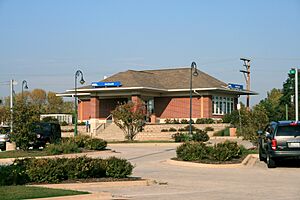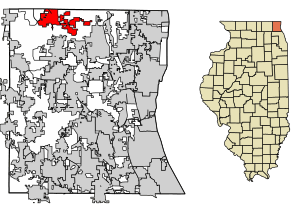Antioch, Illinois facts for kids
Quick facts for kids
Antioch, Illinois
|
||
|---|---|---|

Antioch Metra station
|
||
|
||
| Nickname(s):
"Gateway to the Chain O'Lakes"
|
||
| Motto(s):
"Authentic by Nature"
|
||

Location of Antioch in Lake County, Illinois.
|
||
| Country | United States | |
| State | Illinois | |
| County | Lake | |
| Township | Antioch | |
| Settled | 1830s | |
| Area | ||
| • Total | 8.63 sq mi (22.35 km2) | |
| • Land | 8.24 sq mi (21.34 km2) | |
| • Water | 0.39 sq mi (1.01 km2) | |
| Population
(2020)
|
||
| • Total | 14,622 | |
| • Density | 1,774.30/sq mi (685.05/km2) | |
| Time zone | UTC-6 (CST) | |
| • Summer (DST) | UTC-5 (CDT) | |
| ZIP code |
60002
|
|
| Area code(s) | 847 | |
| FIPS code | 17-01595 | |
| Per capita income: | $36,353 (2014) | |
| Home value: | $218,800 (2014) | |
Antioch is a village located in Lake County, Illinois, USA. In 2020, about 14,622 people lived there. The village is nestled into the Chain O'Lakes waterway system. It also borders the state of Wisconsin. Antioch is part of the larger Chicago metropolitan area. It's about halfway between Chicago (60 miles south) and Milwaukee (50 miles north).
Contents
Antioch's History: A Look Back
Who Lived Here First? Native Americans
Long ago, the Pottawatomi Tribe lived in the area where Antioch is now. European settlers moved into the region in the 1830s. This caused the tribe to move west. Even so, some of their history can still be found today.
How Did European Settlers Shape Antioch?
The first European settlements were along a creek called "Sequoit." This name means "winding." The Gage brothers, Darius and Thomas, built the first cabin. Later, Hiram Buttrick built a sawmill on Sequoit Creek. This creek flows into the Fox River. The sawmill helped the area become a busy trading center.
In 1843, new settlers gave the area the biblical name "Antioch." They also started a school. The town grew as more people, mostly from England and Germany, started farms and businesses. In 1976, a copy of Buttrick's old mill was built. It stands close to where the original mill once was. Today, many local groups and even Antioch Community High School use the name "Sequoit."
Antioch was important in the movement to end slavery. It sent many young men to fight for the Union Army during the Civil War. By the late 1800s, Antioch became a popular place for people from Chicago to visit. Tourism grew fast after a train line to Chicago was built in 1886. Fires destroyed much of downtown in 1891, 1903, and 1904.
During a time called Prohibition, a famous person named Al Capone had a summer home nearby. After World War II, Antioch continued to grow in population and economy. An industrial park was built in the 1970s. Today, Antioch is a "bedroom community." This means many people who live there travel to work in the Chicago or Milwaukee areas.
Antioch's Location and Landscape
Antioch is located at 42°28′45″N 88°5′27″W / 42.47917°N 88.09083°W. It is about halfway between Chicago and Milwaukee.
The village covers about 8.6 square miles (22.3 square kilometers). Most of this area is land, with about 0.39 square miles (1.01 square kilometers) being water.
Antioch sits in a gently rolling landscape. This area was shaped by glaciers long ago. Many lakes formed from these glaciers. Some of these lakes include Antioch Lake, Lake Marie, and Redwing Slough Lake. There are also smaller lakes, ponds, and wetland areas.
What is Antioch's Climate Like?
Antioch has a humid continental climate. This means it experiences four different seasons. Each year, Antioch gets about 36.74 inches (933 mm) of rain and snow.
| Climate data for Antioch, IL (1981-2010; extremes 1901–present) | |||||||||||||
|---|---|---|---|---|---|---|---|---|---|---|---|---|---|
| Month | Jan | Feb | Mar | Apr | May | Jun | Jul | Aug | Sep | Oct | Nov | Dec | Year |
| Record high °F (°C) | 63 (17) |
70 (21) |
86 (30) |
90 (32) |
94 (34) |
100 (38) |
105 (41) |
104 (40) |
102 (39) |
89 (32) |
78 (26) |
68 (20) |
105 (41) |
| Mean daily maximum °F (°C) | 29.0 (−1.7) |
33.0 (0.6) |
43.8 (6.6) |
57.1 (13.9) |
68.1 (20.1) |
78.0 (25.6) |
82.1 (27.8) |
80.6 (27.0) |
73.3 (22.9) |
60.9 (16.1) |
46.8 (8.2) |
33.1 (0.6) |
57.2 (14.0) |
| Mean daily minimum °F (°C) | 13.9 (−10.1) |
17.3 (−8.2) |
26.8 (−2.9) |
37.5 (3.1) |
47.4 (8.6) |
57.4 (14.1) |
62.5 (16.9) |
61.3 (16.3) |
53.4 (11.9) |
41.0 (5.0) |
31.1 (−0.5) |
18.6 (−7.4) |
39.0 (3.9) |
| Record low °F (°C) | −29 (−34) |
−25 (−32) |
−15 (−26) |
6 (−14) |
23 (−5) |
33 (1) |
41 (5) |
38 (3) |
27 (−3) |
17 (−8) |
−6 (−21) |
−24 (−31) |
−29 (−34) |
| Average precipitation inches (mm) | 1.60 (41) |
1.48 (38) |
2.09 (53) |
3.21 (82) |
4.24 (108) |
4.71 (120) |
3.57 (91) |
4.08 (104) |
3.54 (90) |
3.09 (78) |
2.75 (70) |
2.32 (59) |
36.68 (934) |
| Source: NOAA | |||||||||||||
Antioch's Population Over Time
| Historical population | |||
|---|---|---|---|
| Census | Pop. | %± | |
| 1880 | 134 | — | |
| 1890 | 303 | 126.1% | |
| 1900 | 522 | 72.3% | |
| 1910 | 682 | 30.7% | |
| 1920 | 775 | 13.6% | |
| 1930 | 1,101 | 42.1% | |
| 1940 | 1,098 | −0.3% | |
| 1950 | 1,307 | 19.0% | |
| 1960 | 2,268 | 73.5% | |
| 1970 | 3,189 | 40.6% | |
| 1980 | 4,419 | 38.6% | |
| 1990 | 6,105 | 38.2% | |
| 2000 | 8,788 | 43.9% | |
| 2010 | 14,430 | 64.2% | |
| 2020 | 14,622 | 1.3% | |
| U.S. Decennial Census 2010 2020 |
|||
What is Antioch's Population Like Today?
In 2020, Antioch had a population of 14,622 people. Most residents were White (77.47%). Other groups included Black or African American (2.91%), Asian (3.32%), and Native American (0.21%). People of two or more races made up 4.71% of the population. About 11.09% of the population was Hispanic or Latino.
In 2000, there were 8,788 people living in Antioch. The average household had 2.72 people. The average family had 3.20 people. About 29.9% of the population was under 18 years old. The median age was 34 years.
Antioch's Economy and Growth
Since 1996, the Metra train service has been very important for Antioch's growth. This train service connects Antioch to Chicago. It has helped new businesses grow near the train station. The village continues to see new businesses and homes being built. Much of this growth is along Illinois Route 173.
Antioch is home to the Pickard China factory. This factory makes fine china for important places like Air Force One and Camp David.
Downtown Antioch has many local shops. You can find clothing stores, restaurants, and gift shops. The downtown area also hosts fun events. These include concerts, craft fairs, parades, and festivals.
Arts, Culture, and Fun in Antioch
Antioch has a performing arts theater called Palette, Masque and Lyre, Inc. (PM&L). It has been active since 1960. The Antioch Fine Arts Foundation (AFAF) also supports arts in the area since 2001.
Antioch Public Library: A Place to Learn
The Antioch Public Library has over 135,000 books and other items. It lends out over 371,000 items each year.
The library started in 1921 as a project by the Antioch Women's Club. Residents donated books to help it begin. The first library was at 934 Main Street. It was open only two days a week. Over the years, the library moved several times. In 1950, the Schroeder family donated land for a new library building. This new building opened in 1970. In 2001, a large addition was built, making the library even bigger. The construction was finished in 2003.
What Can You Do for Fun in Antioch?
The Chain O'Lakes is a great place for water activities. People enjoy boating and other summer fun. In winter, skiing and snowmobiling are popular. Antioch and nearby Fox Lake host many professional and amateur fishing tournaments.
Kite flying is also a popular event on Loon Lake. This happens during Labor Day Weekend. In 2017, a record was set for the longest kite flight there. It lasted 1 hour and 24 minutes.
The village is also next to four areas managed by the Lake County Forest Preserve District. These are great for outdoor activities.
|
|
Schools in Antioch
Antioch has several public schools. Not all students living in Antioch attend these specific schools.
- Public Schools
- Elementary Schools (Kindergarten to 5th grade)
- W.C. Petty Elementary School
- Hillcrest Elementary School
- Antioch Elementary School
- Elementary Schools (Pre-Kindergarten to 8th grade)
- Emmons Grade School
- Grass Lake Elementary School
- Middle School (6th to 8th grade)
- Antioch Upper Grade School
- High School (9th to 12th grade)
- Antioch Community High School
Private Schools in Antioch
- Private Middle Schools
- St. Peter Catholic School (Grades PK-8) - Note: This school is now closed.
Getting Around Antioch: Transportation
Metra train service connects Antioch to Chicago Union Station. This is part of the North Central Service. Bus service within Antioch and Lake County is provided by Pace.
Western Kenosha County Transit Route 2 also serves parts of Antioch. This bus connects riders to towns in Kenosha County, Wisconsin. You can also transfer to other routes to reach Kenosha and Lake Geneva.
Antioch is about 43 miles north of Chicago O'Hare International Airport. It is also about 40 miles south of General Mitchell International Airport in Milwaukee.
Main Roads in Antioch
Several important highways and state routes pass through or near Antioch.
Famous People from Antioch
- Dale Barnstable (1925-2019) – A two-time NCAA Basketball champion for the University of Kentucky.
- Tiffany Brooks (born 1979) – She won the 2013 HGTV Design Star competition.
- Paul DeJong (born 1993) – A Major League Baseball player for the Kansas City Royals.
- Fred Hawkins (1923-2014) – A professional golfer on the PGA Tour.
- Jim McMillen (1902-1984) – He played guard for the Chicago Bears. He also served as mayor of Antioch.
- John Thain (born 1955) – A well-known business leader. He was CEO of Merrill Lynch and the New York Stock Exchange.
- Tom Wittum (1950-2010) – A football player for the San Francisco 49ers.
Images for kids
See also
 In Spanish: Antioch (Illinois) para niños
In Spanish: Antioch (Illinois) para niños




